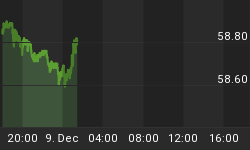As the whole world expected, the FOMC today raised its fed funds target by 25 basis points to 5-1/4% -- a cumulative 425 basis point increase over a two-year span. Because the FOMC has been raising the funds rate by only 25 basis points per meeting, people seem to ignore the cumulative effect of these rate hikes. (See "The Boiled Frog and the Fed", for a discussion of this.) You would have to go back to the Volcker years of the early 1980s to find a 2-year cumulative increase in the fed funds rate of greater absolute or relative value. As this is being written, the 10-year Treasury note is yielding 5.20%. Therefore, the yield spread between it and the fed funds target has turned negative - historically an indication of a restrictive monetary policy. In terms of the CPI, the year-over-year percent change in real M2 in May was about one-half of one percent - historically an indication of a restrictive monetary policy. Assuming a year-over-year percent change in the core PCE price index of 2.1% for June, the spread of the fed funds rate over this measure of core inflation would be 315 basis points compared to a long-run average spread of 250 basis points. The real fed funds rate is neither mine nor the Conference Board's favorite leading indicators. But I imagine that those who believe this measure of the "real" fed funds rate is a good leading indicator also now think that monetary policy has crossed over to the "dark" side.
And by the subtle changes in the wording of its statement, it would appear that the FOMC also believes that monetary policy is on the restrictive side of neutral. For example, the FOMC back on May 10 was forecasting a slowdown in economic growth. Today, it thinks that slowdown has arrived.
May 10 FOMC statement: "The Committee sees growth as likely to moderate to a more sustainable pace ..."
June 29 FOMC statement: "Recent indicators suggest that economic growth is moderating from its quite strong pace earlier this year ..."
Back on May 10, the FOMC thought that certain factors could push inflation higher. Today, it believes that although these same factors could keep inflation at its elevated level, it does not see them adding to inflation pressures.
May 10 FOMC statement: "Still, possible increases in resource utilization, in combination with the elevated prices of energy and other commodities, have the potential to add to inflation pressure [emphasis added]."
June 29 FOMC statement: "However, the high levels of resource utilization and of the prices of energy and other commodities have the potential to sustain inflation pressures [emphasis added]."
So, the FOMC now believes that weaker economic growth is here and, although inflation currently is uncomfortably high, "the moderation in the growth of aggregate demand should help to limit inflation pressures over time..."
Back on May 10, the FOMC judged "that some further policy firming may yet be needed to address inflation risks ..." Today, the FOMC signaled less prejudice about further rate hikes by not leading off the policy outlook paragraph with the threat and then saying: "The extent and timing of any additional firming that may be needed to address these risks will depend on the evolution of the outlook for both inflation and economic growth, as implied by incoming information."
If, as I expect, between now and August 8 core PCE-price inflation does not move much above its April reading of 2.1% and there continue to be signs of moderation in economic growth, the FOMC is likely stand pat at the August 8 meeting. In fact, I believe that today's funds rate hike is the last one of the year. Chairman Bernanke will take the opportunity at his July 19 Senate Financial Services Committee hearing to "educate" us about how slowing aggregate demand, with a lag, results in moderating inflation. But to help establish his credentials as a staunch defender of price stability, he also will tell us that if the Fed's forecast of moderating growth in aggregate demand fails to materialize and/or some other inflationary factors emerge, he will not hesitate recommending to the FOMC that it act to reduce inflation.
















